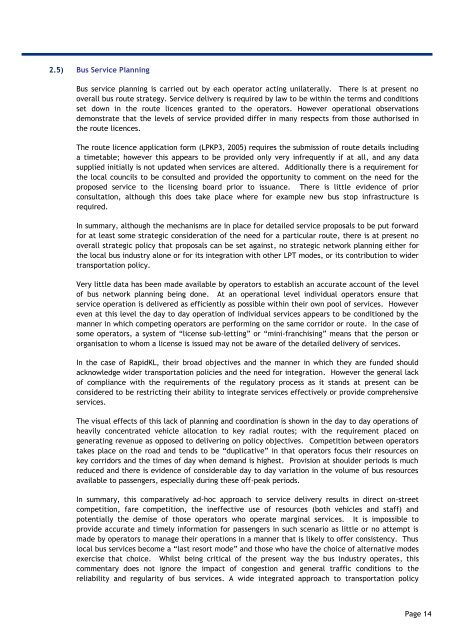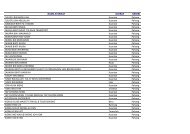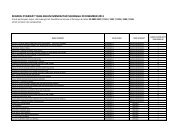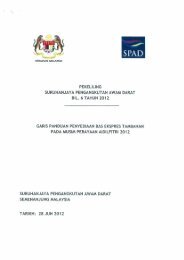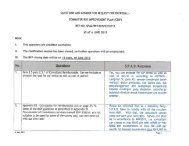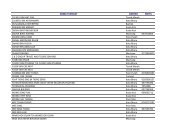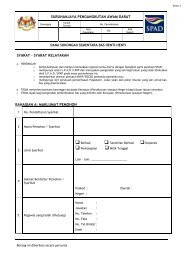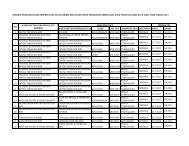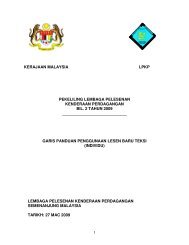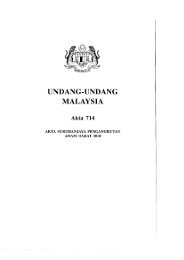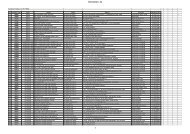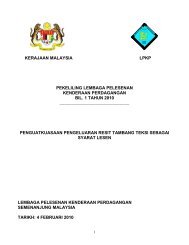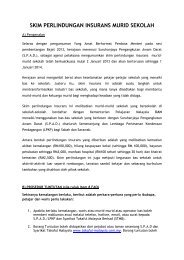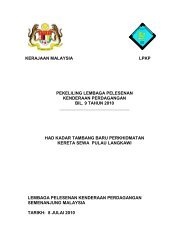Contents - SPAD
Contents - SPAD
Contents - SPAD
Create successful ePaper yourself
Turn your PDF publications into a flip-book with our unique Google optimized e-Paper software.
2.5) Bus Service Planning<br />
Bus service planning is carried out by each operator acting unilaterally. There is at present no<br />
overall bus route strategy. Service delivery is required by law to be within the terms and conditions<br />
set down in the route licences granted to the operators. However operational observations<br />
demonstrate that the levels of service provided differ in many respects from those authorised in<br />
the route licences.<br />
The route licence application form (LPKP3, 2005) requires the submission of route details including<br />
a timetable; however this appears to be provided only very infrequently if at all, and any data<br />
supplied initially is not updated when services are altered. Additionally there is a requirement for<br />
the local councils to be consulted and provided the opportunity to comment on the need for the<br />
proposed service to the licensing board prior to issuance. There is little evidence of prior<br />
consultation, although this does take place where for example new bus stop infrastructure is<br />
required.<br />
In summary, although the mechanisms are in place for detailed service proposals to be put forward<br />
for at least some strategic consideration of the need for a particular route, there is at present no<br />
overall strategic policy that proposals can be set against, no strategic network planning either for<br />
the local bus industry alone or for its integration with other LPT modes, or its contribution to wider<br />
transportation policy.<br />
Very little data has been made available by operators to establish an accurate account of the level<br />
of bus network planning being done. At an operational level individual operators ensure that<br />
service operation is delivered as efficiently as possible within their own pool of services. However<br />
even at this level the day to day operation of individual services appears to be conditioned by the<br />
manner in which competing operators are performing on the same corridor or route. In the case of<br />
some operators, a system of “license sub-letting” or “mini-franchising” means that the person or<br />
organisation to whom a license is issued may not be aware of the detailed delivery of services.<br />
In the case of RapidKL, their broad objectives and the manner in which they are funded should<br />
acknowledge wider transportation policies and the need for integration. However the general lack<br />
of compliance with the requirements of the regulatory process as it stands at present can be<br />
considered to be restricting their ability to integrate services effectively or provide comprehensive<br />
services.<br />
The visual effects of this lack of planning and coordination is shown in the day to day operations of<br />
heavily concentrated vehicle allocation to key radial routes; with the requirement placed on<br />
generating revenue as opposed to delivering on policy objectives. Competition between operators<br />
takes place on the road and tends to be “duplicative” in that operators focus their resources on<br />
key corridors and the times of day when demand is highest. Provision at shoulder periods is much<br />
reduced and there is evidence of considerable day to day variation in the volume of bus resources<br />
available to passengers, especially during these off-peak periods.<br />
In summary, this comparatively ad-hoc approach to service delivery results in direct on-street<br />
competition, fare competition, the ineffective use of resources (both vehicles and staff) and<br />
potentially the demise of those operators who operate marginal services. It is impossible to<br />
provide accurate and timely information for passengers in such scenario as little or no attempt is<br />
made by operators to manage their operations in a manner that is likely to offer consistency. Thus<br />
local bus services become a “last resort mode” and those who have the choice of alternative modes<br />
exercise that choice. Whilst being critical of the present way the bus industry operates, this<br />
commentary does not ignore the impact of congestion and general traffic conditions to the<br />
reliability and regularity of bus services. A wide integrated approach to transportation policy<br />
Page 14


